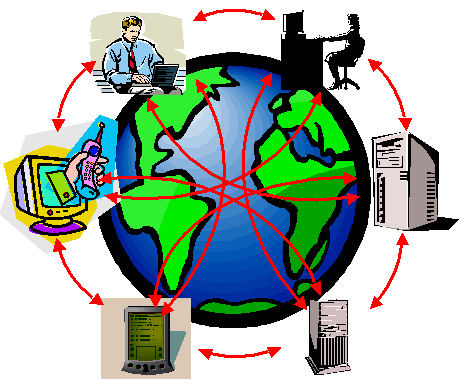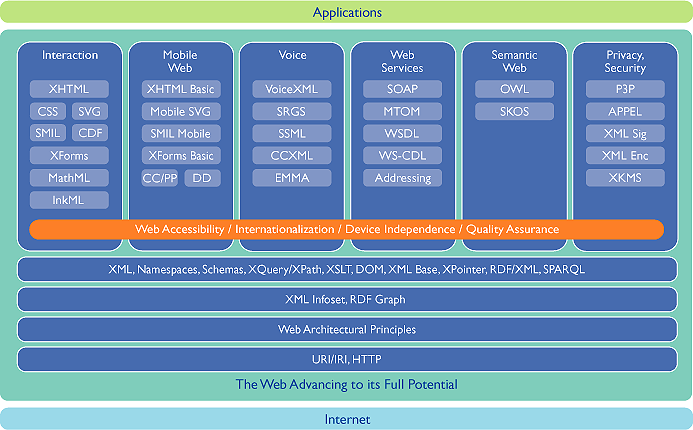
لإيصال الشبكة
المعلوماتية إلىأقصى إمكانياتها...
引发网络的全部潜能…
Pаскрывая весь
потенциал Сети…
Οδηγώντας τον παγκόμιο
ιστό στο μέγιστο των δυνατοτήτων του…
להוביל את הרשת
למיצוי הפוטנציאל שלה...
Webの可能性を最大限に導き出すために…
웹의 모든 잠재력을 이끌어
내기 위하여…
Hogy kihasználhassuk a Web nyújtotta
összes lehetőséget…
ਵੈਬ ਨੂੰ ਉਸਦੇ
ਸੰਪੂਰਣ ਸਮਰੱਖਾ 'ਤੇ ਪਹੂੰਚਾਉਣਾ
...
การนําไปสู่
Webที่เต็มไปด้วยศักยภาพ
W3C's Mission: Leading the Web to its Full Potential
Founded by Web inventor Tim Berners-Lee in
1994:
- Providing the Vision to Lead.
- Engineering the Standards that Make the Web Work:
XML, HTTP, HTML, CSS, WAI, etc
 |
- From a Web of Documents ...
- ... toward a Web of data and services that is:
- Meaning-ful
- on Everything
- for Everyone
- ... and Interoperable, Trustworthy, Evolvable,
Decentralized and Worldwide
|
(Flyer: US, A4 / History)
The World's Web Standards Organization
W3C's expanding international basis of operations
(map)
W3C Brings the World Together to Engineer the Web
- ~ 400
Members (png,
map
history)
- world's leading technology organizations
- commercial, academic, research institutions, government agencies,
non-profit
Developing Standards at W3C
- Clear and effective Process,
which encourages:
- Vendor neutrality
- Consistent architecture
- Coordination, consensus
and interoperability
- No "rubber stamping"
- Must engineer dependencies (inside and outside of W3C)
Views of the Process: Life of
Working Group, Recommendation
Track
W3C Technologies
Over 80 Standards (Recommendations) have been released
(List
/ SVG-by-yr/
Translations)

(Organization of work: SVG-from-RDF, PNG)
What's Next?
Recently started work, and ideas for new work
...
- Web of Meaning
- Semantic Web: Best Practices*,
Query*, Rules, Life Sciences,
Filtering
- Web Services: Performance*,
Addressing*, SemWeb Services*, Policy,
Security, Trust
- XML: Binary*, Schema User
Experience
* Recently started
W3C and Grid (1)
- Why Grid now ?
- Context: Growth in network bandwidth + rise of
network distributed culture
- Driver: Enterprise customers need
scalable services + scientific research needs large computational
power and datasets.
- Layer model: The Grid
platform is a user of the Web platform, much like the
Web is a user of the Internet.
- The Grid needs the Web: http, XML, Web Services, Semantic Web
- The Web needs the Internet: DNS, IP, Mime, etc.
- (where's HTTP - the first IETF/W3C working group - for the
Grid?)
- W3C's position: The
Grid is a technical community that use our technologies,
among many others technical communities.
- e.g. Life Science, Mobile, eGoverment, Oil Industry, Airline
Booking, etc.
- Our SDO resources are limited, for interfacing as
well.
W3C and Grid (2)
- WS Foundations: The Web
Services architecture is still evolving bottom-up style, and the OGSA roadmap assumes
stability at this level.
- Grid architects should participate more in
design and evolution of W3C technologies.
- Grid developers should implement W3C
Recommendations in priority.
- Interoperability between Grids should start with
Networking interoperability.
- We hope the Grid platform will improve it the Web.
- How can W3C help ?: a
decade of expertise in delivering Open Standards
(technical coordination and leadership, consensus and running code, clear
patent policy, universality, persistence).
- With enough support, W3C could start a Grid
activity to stabilize and improve the WS stack, look at
Binary XML together - and avoid conflict with GGF binary encoding
work?, look at Grid Semantic Web as well.
- W3C has various instruments like
Workshop, Working Group, Incubator, Interest Group, that can be used
to host a new standard related activity.
- We could start with a fellow
(pro bono Grid/Web expert on loan as W3C staff) to study and organize
all that work following the W3C process, attend the GGF SCRM
group, link with Life Science community, seen as both a Grid and
a Semantic Web user.
Thank you!



